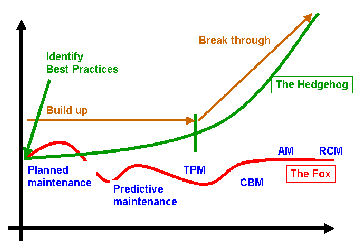It is not uncommon that many reliability and maintenance improvement initiatives fail to deliver expected results. Why is it so?
Some of the most common causes I have observed include:
- Lack of top management understanding, directive and long term support.
- Initiatives are shortsighted and too cost focused instead of long term and reliability focused.
- Politics and disjointed organizational goals and objectives.
- Mobility of management.
- Confusing the organization with new names on well known concepts.
- Failing to understand that the reliability and maintenance improvement initiative is a process without an end, not a program with an end.
- It is a process driven by disciplined thoughts and actions by people.
- Technology is secondary to behavior and will be very successfully applied when an organization is ready.
In his best seller book “Good to Great” (ISBN 0-06-662099-6), Jim Collins uses the famous essay “The hedgehog and the fox” by Isaiah Berlin as a comparison between good companies and great companies.
The book is based on a detailed investigation of what the great companies share in common that distinguished them from good companies.
In summary, and as a parallel with reliability and maintenance improvement initiatives, the great companies knew one thing they can be best in the world at. Then they did this for a long time.
The study was based on a 30 years period and all great companies sustained their results also after fifteen years.
The great companies can be described as hedgehogs the good, but not great, companies can be described as foxes. The fox companies often changed plans and many tried to outsmart the market with short term initiatives.
Their leaders were glamorous and well known. The leaders of the great companies had much lower visibility.
The great companies typically worked with disciplined implementation for fifteen years before they made a significant positive break through in financial performance and they sustained this performance for fifteen years and beyond that.
So how does this relate to reliability and maintenance improvements?
In graph one I make an attempt to describe the difference between the hedgehog versus the fox approach. The majority of organizations I know can be classified as foxes, the most successful companies are hedgehogs.

The fox organizations will try all new tricks.
Perhaps it started many years ago when a new manager implemented “Planned maintenance”, this lead to short, but not sustained, improvements so the next initiative, often with a new manager, was “Predictive maintenance”.
Again short term results were generated. When results disappeared the next action was to implement TPM (Total Productive Maintenance).
When also this initiative failed to give the significant results that had been expected it was time to enter into AM (Asset Management) and then RCM (Reliability Centered Maintenance). Almost all initiatives were initiated by changes in management.
The hedgehog organizations find out the things that need to be executed well. They spend time to identify Best Practices.
Then they execute disciplined thoughts and actions according to their Best Practices. For long time they implement in a disciplined manner, and as a result, they will come to a point when significant results will be generated after a break through.
Some organizations have seen this break through after three to seven years. New managers will be requested to continue implementation of Best Practices.
The fox approach confuses organizations and people will not believe that the latest improvement initiative is there for a long term. The consequence is lack of true and enthusiastic commitment which is vitally important for success.
The hedgehog approach stabilizes the organization to focus on continually improving the right things.
If you would like to discuss your own maintenance improvement intiatives, then we would love to help.
Give us a call or email is today at [email protected].





